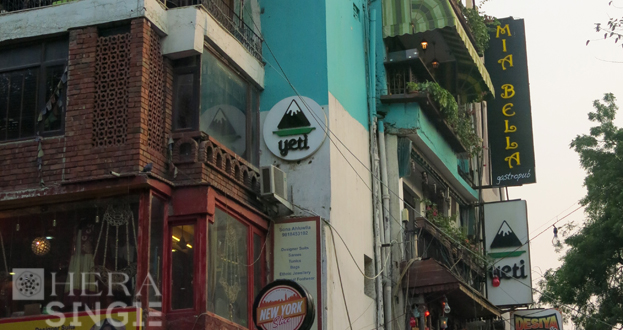
Swallowed by the city’s rapid expansion some of Delhi’s urbanised villages have recently undergone a stark metamorphosis shaped by heightened consumerism and new urban lifestyles.
With liberalisation heralding in a new consumer culture, Delhi’s cityscape, too, has undergone significant transformations. Moulded by ‘world-class city’ aesthetics and the ongoing commercialisation of space (Ghertner, 2011), high rises, mega-malls and elite enclaves are now part of its built environment, acting as signifiers for progress and global modernity in the imaginative landscape of a cosmopolitan postcolonial capital. Alongside these more grand-scale projects of ‘spectacular’ urbanism another distinctive spatial configuration has come to characterise the mosaic of Delhi’s urban vista: the newly gentrified urban village.
In the course of Delhi’s rapid expansion, former rural settlements were incorporated into the city’s limits to meet the needs of rapid population growth. While the agricultural land of these urbanized villages was gradually developed into residential colonies, their inhabited areas were left largely untouched and exempted from building by-laws and regulations. Today some of these urban villages have become implicated in the practice of theming select neighbourhoods characteristic of postmodern urbanism. In European and American cities creative and cultural quarters are for instance branded as carnivalesque spaces dominated by particular forms of consumption and urban lifestyles.
One of Delhi’s urban villages, namely Hauz Khas Village, has emerged as the most striking example of this development. It was first popularised as a fashion designer hub in the late eighties and early nineties (Tarlo 1996), then ‘rediscovered’ twenty years later, when low-cost housing attracted a population of artists, musicians and writers looking to participate in a burgeoning sub-cultural scene. Cultural and creative businesses in advertising, architecture, visual arts, design, film, music and digital media set up their offices in the centrally located neighbourhood as zoning laws of the surrounding planned city restricted commercial businesses in other residential areas. As a site of experimentation for the city’s young populace, the village became a place where alternative lifestyles, entrepreneurial subjectivities and creative pursuits could be tried and tested. The young were drawn to Hauz Khas Village not only because of favourable rent environment, but also due to the less rigid separation between residential and commercial spaces and a mix of social groups, which were perceived to enhance street level vibrancy. Hauz Khas Village soon drew bigger crowds looking to bask in its creative, metropolitan aura. Known well beyond Delhi borders, parallels are drawn to New York’s East Village, further affirming its centrality to a young generation not wanting to miss out on Delhi’s urban cool scene.
The city’s fast-paced growth of the food and beverage industry, an intensifying consumer culture, as well as increased surplus capital flow eventually led to an intense surge of popularity with the number of restaurants and bars swiftly multiplying. Very few small-scale restaurants and bars currently remain to compete with big players in the food and beverage industry, with coffee chain Starbucks being the latest to open its gates in November 2015. Long past its more unobtrusive days of alternative entertainment Hauz Khas Village is nowadays derided by the urban elite as irredeemably lost in the morass of mass consumerism. While some continue to reap the benefits of Hauz Khas Village’s integration into the commerce and service sector of the city, rent hikes, even in the less desirable locations, and an overstrained infrastructure hamper benefits for low-income groups. Congestion and haphazard construction work have furthermore contributed to what many see as serious safety hazards.
Yet, the Village also offers opportunities otherwise hard to come by in Delhi’s contentious landscape: an open space for mixed gender sociality, as well as easy access for young women to move around unobstructed. As restaurant owners and landlords are eager to retain the flow of customers, women have come to constitute a desired category further legitimising the Village’s claim to be a modern urban hub. Reminiscent of Sanjay Srivastava’s (2013) discussions on the figure of the female shopping mall consumer in new narratives of urban modernity, the Village’s commercialisation creates possibilities to experience a relaxed form of sociality usually reserved for men. Nevertheless this access remains contingent on the imperative of conspicuous consumption.
Hauz Khas Village has become a site in which young urbanites chart a new urban geography drawing on transnational trends, global imaginaries of urbanity and cosmopolitan consumption, as well as professional and creative innovation. It thereby demonstrates the impact of new lifestyle and consumption habits of the middle-classes on the urban landscape of an increasingly socially and spatially polarised city.
All photos by Lucie Bernroider 2015
Bibliography
GHERTNER A. D. (2011) Rule by aesthetics: world class city making in Delhi,’ in Roy A. & Ong A. (eds), Worlding Cities. Asian Experiments and the art of Being Global. Oxford: Blackwell
SRIVASTAVA, S. (2013) ‘Shop Talk: Shopping Malls and Their Publics’, in Mathur, N. (ed.), Consumer Culture, Modernity and Identity. New Delhi: SAGE, pp 45-70
TARLO, E. (1996) Clothing Matters: Dress and Identity in India. London: Hurst